

Shibui. Defining shibui or shibusa[edit] Shibusa is an enriched, subdued appearance or experience of intrinsically fine quality with economy of form, line, and effort, producing a timeless tranquility.

Shibusa includes the following essential qualities: (1) Shibui objects appear to be simple overall but they include subtle details, such as textures, that balance simplicity with complexity.(2) This balance of simplicity and complexity ensures that one does not tire of a shibui object but constantly finds new meanings and enriched beauty that cause its aesthetic value to grow over the years.(3) Shibusa is not to be confused with wabi or sabi. Though many wabi or sabi objects are shibui, not all shibui objects are wabi or sabi.
Wabi or sabi objects can be more severe and sometimes exaggerate intentional imperfections to such an extent that they can appear to be artificial. Jo-ha-kyū. Jo-ha-kyū (序破急?)
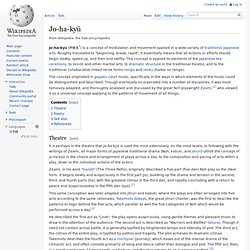
Is a concept of modulation and movement applied in a wide variety of traditional Japanese arts. Roughly translated to "beginning, break, rapid", it essentially means that all actions or efforts should begin slowly, speed up, and then end swiftly. This concept is applied to elements of the Japanese tea ceremony, to kendō and other martial arts, to dramatic structure in the traditional theatre, and to the traditional collaborative linked verse forms renga and renku (haikai no renga). The concept originated in gagaku court music, specifically in the ways in which elements of the music could be distinguished and described. Though eventually incorporated into a number of disciplines, it was most famously adapted, and thoroughly analysed and discussed by the great Noh playwright Zeami,[1] who viewed it as a universal concept applying to the patterns of movement of all things.
Theatre[edit] Poetry[edit] See also[edit] References[edit] Jump up ^ Zeami. Ensō. Ensō (c. 2000) by Kanjuro Shibata XX.
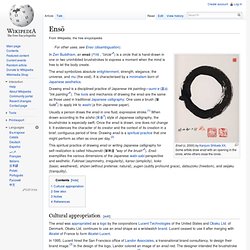
Some artists draw ensō with an opening in the circle, while others close the circle. In Zen Buddhism, an ensō (円相, , "circle"?) Is a circle that is hand-drawn in one or two uninhibited brushstrokes to express a moment when the mind is free to let the body create. Mono no aware. Mono no aware (物の哀れ?)
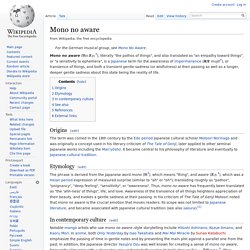
, literally "the pathos of things", and also translated as "an empathy toward things", or "a sensitivity to ephemera", is a Japanese term for the awareness of impermanence (無常, mujō?) , or transience of things, and both a transient gentle sadness (or wistfulness) at their passing as well as a longer, deeper gentle sadness about this state being the reality of life. Origins[edit] The term was coined in the 18th century by the Edo period Japanese cultural scholar Motoori Norinaga and was originally a concept used in his literary criticism of The Tale of Genji, later applied to other seminal Japanese works including the Man'yōshū. It became central to his philosophy of literature and eventually to Japanese cultural tradition. Etymology[edit] The phrase is derived from the Japanese word mono (物?) Kireji. Kireji (切れ字, lit.

"cutting word"?) Miyabi. The ideal posed by the word demanded the elimination of anything that was absurd or vulgar and the "polishing of manners, diction, and feelings to eliminate all roughness and crudity so as to achieve the highest grace.

" It expressed that sensitivity to beauty which was the hallmark of the Heian era. Miyabi is often closely connected to the notion of Mono no aware, a bittersweet awareness of the transience of things, and thus it was thought that things in decline showed a great sense of miyabi. An example of this would be one of a lone cherry tree. The tree would soon lose its flowers and would be stripped of everything that made it beautiful and so it showed not only mono no aware, but also miyabi in the process. Wabi-sabi. A Japanese tea house which reflects the wabi-sabi aesthetic in Kenroku-en (兼六園) Garden Wabi-sabi (侘寂?)
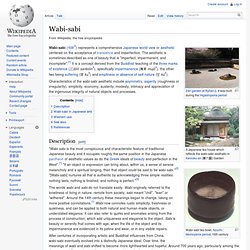
Iki (aesthetic ideal) Iki (いき, often written 粋) is a traditional aesthetic ideal of human behavior or volition in Japan, roughly "chic, stylish".
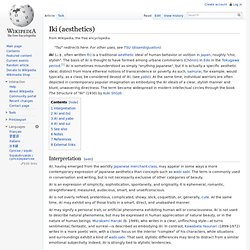
The basis of iki is thought to have formed among urbane commoners (Chōnin) in Edo in the Tokugawa period.[1] Iki is sometimes misunderstood as simply "anything Japanese", but it is actually a specific aesthetic ideal, distinct from more ethereal notions of transcendence or poverty. Japanese aesthetics. The modern study of Japanese aesthetics in the Western sense only started a little over two hundred years ago.
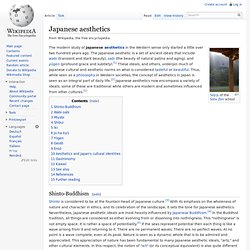
The Japanese aesthetic is a set of ancient ideals that include wabi (transient and stark beauty), sabi (the beauty of natural patina and aging), and yūgen (profound grace and subtlety).[1] These ideals, and others, underpin much of Japanese cultural and aesthetic norms on what is considered tasteful or beautiful. Thus, while seen as a philosophy in Western societies, the concept of aesthetics in Japan is seen as an integral part of daily life.[2] Japanese aesthetics now encompass a variety of ideals; some of these are traditional while others are modern and sometimes influenced from other cultures.[1] Shinto-Buddhism[edit] Shinto is considered to be at the fountain-head of Japanese culture.[3] With its emphasis on the wholeness of nature and character in ethics, and its celebration of the landscape, it sets the tone for Japanese aesthetics.